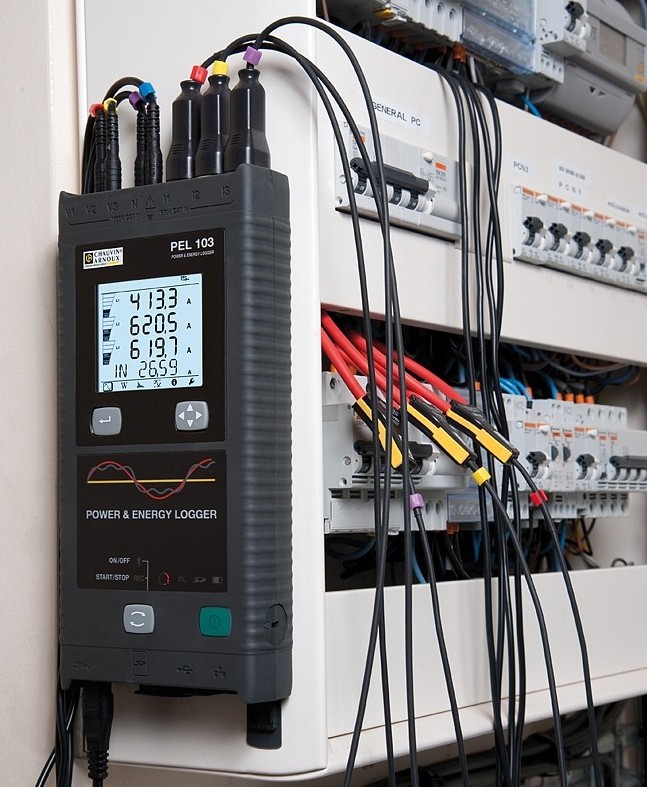
As part of the government’s attempts to build back greener after coronavirus, Chancellor Rishi Sunak has revealed a Public Sector Decarbonisation Scheme. This billion-pound program is aimed at improving energy efficiency in schools, hospitals and other public buildings. It is part of the UK’s efforts to reduce the public sector’s greenhouse gas emissions by 50% in a bid to meet legally binding targets of net zero emissions by 2050. Portable energy loggers, such as Chauvin Arnoux’s PEL103, are vital tools when it comes to measuring energy consumption and efficiency. These relatively inexpensive instruments can be used to establish an initial benchmark prior to implementing changes. Additionally, PELs can pinpoint where improvements would be most effective and can be used to monitor progress over time.
The Public Sector Decarbonisation Scheme is intended to ‘help public sector organisations in England, including central government departments and their agencies, local authorities, schools and NHS Trusts, to install energy efficiency and low carbon heating measures [to reduce] energy bills and carbon emissions.’[1] The grants offered by the PSDS ‘include £560 million in additional condition improvement funding for 2020-21 and £1-billion for 50 rebuilding schemes starting from September 2021.’[2] It is hoped that these measures will achieve a reduction of 0.1 metric tons of carbon dioxide (MtCO2e) per year, and 0.5 metric tons of carbon dioxide (0.5 MtCO2e) over the next two five-year Carbon Budgets. This is equivalent to removing 45 000 cars from the roads.[3] The Public Sector Decarbonisation Scheme is overseen by the Department of Business, Energy and Industrial Strategy.[4] Applications are now open; please consult the government’s website for further information.

In the meantime, a PEL, such as the aforementioned Chauvin Arnoux PEL103 Portable Energy Logger, can be used to establish the type, volume, and source of power consumption. This allows facilities managers to identify the points at which energy efficiency can be improved, thereby reducing energy costs and greenhouse gas emissions. They can be quickly and easily installed in distribution cabinets and are suitable for monitoring lighting, HVAC, display screens, and computer circuits.
In addition to monitoring power consumption, harmonic levels, voltage imbalance, and power factor, the Chauvin Arnoux PEL103 Portable Energy Logger can measure voltage, frequency, current, real power, reactive power and harmonic levels. Time-stamped readings are automatically saved to the Chauvin Arnoux PEL103 Portable Energy Logger’s memory and can be stored for minutes, days, weeks or months depending on the user’s requirements.
Time-stamped readings provide interesting and vital insights into power consumption. British Gas estimates that approximately ‘46% of electrical energy used by SMEs is consumed outside of normal business hours.’[5] This can be due to equipment, which is not needed during shutdown, being switched on and off by automatic timers. Time-stamped readings provide an easy way of identifying these appliances. Other sources of power consumption may be attributed to leaving lights, computers and office equipment switched on. This was found to be the case at a secondary school in Kent at which Chauvin Arnoux recently completed a power consumption project.
Chauvin Arnoux monitored the school’s power consumption over an eleven-day period which included half-term holidays, a weekend, and a working week. The findings showed that there was a load of approximately 30A per phase at the weekend and a phase imbalance was causing excessive current flow in neutral. Additionally, the third and fifth harmonics were unexpectedly high; it was established that an increase in the third harmonic was caused by personal computers, office appliances and electronic lighting, while the increase in the fifth harmonic could be attributed to the server UPS. [6]
Peter Halloway, Regional Sales Manager at Chauvin Arnoux, explained that ‘having analysed the data we had recorded over the eleven-day period, we were able to recommend a solution that would balance the loads and [explained] how to reduce the harmonics by fitting filters… An even simpler solution however would have been to educate staff to turn off lighting and equipment at the end of the day or even install systems to turn it off automatically.’[7]
For further information regarding this case study, please see Chauvin Arnoux’s article, Taking the first step towards green buildings, available here.
Another common cause of energy consumption and excessive energy costs is poor power factor. Electrical loads consume both active and reactive power. Active power is essential for completing tasks, e.g. lighting lights or turning a motor; however, reactive power doesn’t perform a useful function but is just as expensive as active power. Facilities managers can monitor power factor using a Chauvin Arnoux PEL103 Portable Energy Logger. If it falls below 1.0, the power factor can be easily corrected using capacitors. This reduces reactive power consumption and, therefore, energy costs and greenhouse gases.[8]
PELs, such as Chauvin Arnoux’s PEL103 Portable Energy Logger, provide a cost-effective solution to monitoring energy efficiency, reducing surplus energy consumption, and, most importantly, decreasing energy costs and greenhouse gas emissions. They are simple and affordable tools that provide the first step to meeting decarbonisation targets and ensuring that funds allocated to improving energy efficiency are spent effectively.
Please browse our complete range of Chauvin Arnoux portable energy loggers and analysers as well as our selection of power quality analysers.
For information, please contact our sales team on 01642 931 329 or via our online form.
[1] GOV.UK, Press Release: Greener homes, jobs and cheaper bills on the way as the government launches the biggest upgrade of the nation’s buildings in a generation, last accessed 13 October 2020 <https://www.gov.uk/government/news/greener-homes-jobs-and-cheaper-bills-on-the-way-as-government-launches-biggest-upgrade-of-nations-buildings-in-a-generation >.
[2] ‘Taking the first steps towards green buildings’, EM Magazine, ed. Ralph Scrivens (September 2020), 18-20. Also available at < https://www.energymanagermagazine.co.uk/taking-the-first-steps-towards-green-buildings/ >, last accessed 13 October 2020.
[3] GOV.UK, Public Sector Decarbonisation Scheme (PSDS), last accessed 13 October 2020 <https://www.gov.uk/government/publications/public-sector-decarbonisation-scheme-psds>.
[4] Consultancy.uk, Government launches £1 billion scheme to decarbonise public sector, last accessed 13 October 2020, < https://www.consultancy.uk/news/25775/government-launches-1-billion-scheme-to-decarbonise-public-sector>.
[5] ‘Taking the first steps towards green buildings’, EM Magazine.
[6] ‘Taking the first steps towards green buildings’, EM Magazine.
[7] ‘Taking the first steps towards green buildings’, EM Magazine.
[8] ‘Taking the first steps towards green buildings’, EM Magazine.


